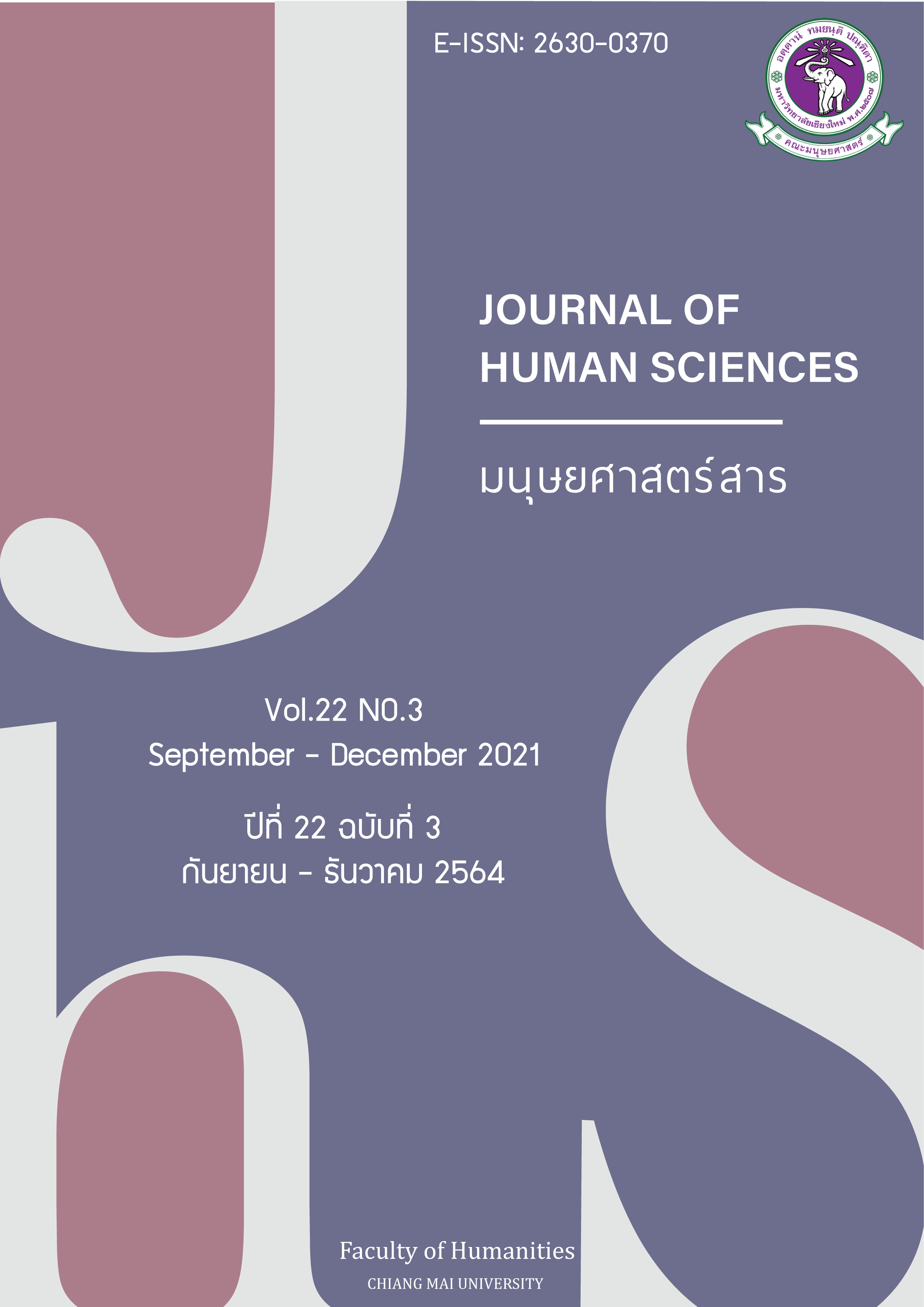การใช้อนุภาคลงท้าย ดิ ของผู้พูดภาษาไทยเป็นภาษาแม่
Main Article Content
บทคัดย่อ
งานวิจัยนี้มุ่งวิเคราะห์หน้าที่การสื่อสารของอนุภาคลงท้าย ดิ จากคลังข้อมูลภาษาไทยแห่งชาติ และศึกษาการใช้ ดิ ของผู้พูดภาษาไทยเป็นภาษาแม่ ในส่วนแรกผู้วิจัยเลือกการปรากฏของ ดิ ในหมวดบันเทิงคดีจากคลังข้อมูลภาษาไทยแห่งชาติ ผลการวิจัยพบว่า ดิ มีหน้าที่การสื่อสารทั้งหมด 4 ประการ ได้แก่ ทำให้ถ้อยคำมีอำนาจ ทำให้ถ้อยคำมีความหนักแน่น แสดงความไม่สนใจหรือไม่พอใจในเรื่องที่กำลังสนทนา และเกริ่นนำหัวเรื่องที่มีความขัดแย้ง เมื่อเปรียบเทียบกับหน้าที่ของ สิ ในงานวิจัยของสุมินตรา มาคล้าย (2559) พบว่าอนุภาคท้ายทั้งสองมีหน้าที่ใกล้เคียงกันมาก ยกเว้นหน้าที่ในการทำให้ถ้อยคำมีความหนักแน่นเมื่อผู้พูดต้องการแสดงว่าตนรู้ทันผู้ฟัง ซึ่งไม่พบการใช้ ดิ จึงมีความเป็นไปได้สูงว่า ดิ เป็นรูปแปรหนึ่งของ สิ และสามารถใช้แทนกันได้แทบทุกบริบท งานวิจัยส่วนที่สองศึกษาการใช้ ดิ ของผู้พูดภาษาไทยเป็นภาษาแม่จำนวน 20 คน แบ่งเป็น 2 กลุ่ม คือ เพศชาย 10 คน และเพศหญิง 10 คน มีการแสดงบทบาทสมมติ 10 สถานการณ์ ซึ่งออกแบบตามผลการวิเคราะห์ส่วนแรก ผลการวิจัยพบว่าทั้งสองกลุ่มใช้ ดิ ในความถี่และความหลากหลายไม่แตกต่างกัน โดยพบหน้าที่ 2 ประการ ได้แก่ ทำให้ถ้อยคำมีอำนาจและทำให้ถ้อยคำมีความหนักแน่น ทั้งนี้ไม่พบหน้าที่ของ ดิ เพื่อแสดงความไม่สนใจหรือไม่พอใจในเรื่องที่กำลังสนทนา และเพื่อเกริ่นนำหัวเรื่องแบบที่มีความขัดแย้ง ทั้งสองหน้าที่ยังพบความถี่การปรากฏน้อยในคลังข้อมูลภาษา ซึ่งอาจเป็นเพราะบริบทสถานการณ์ค่อนข้างเฉพาะและไม่พบในชีวิตประจำวันบ่อยนัก ผลการวิจัยยังชี้ให้เห็นว่าปัจจัยเรื่องเพศไม่มีผลต่อการใช้อนุภาคลงท้าย
Article Details

อนุญาตภายใต้เงื่อนไข Creative Commons Attribution-NonCommercial-NoDerivatives 4.0 International License.
เอกสารอ้างอิง
University.
Cheunkongchoo, T. (1956). The prosodic characteristics of certain particles in spoken Thai. (M.A. Thesis), London: University of London.
Cooke, J. R. (1989). Thai sentence particles and other topics. Canberra: Department of Linguistics, Research school of Pacific Studies, The Australian National University.
Drasovean, A., & Tagg, C. (2015). Evaluative language and its solidarity-building role on TED.com: An appraisal and corpus analysis. Language@Internet, 12(1), Retrieved from https://www.languageatinternet.org/articles/2015/drasovean
Emmott, C. (1997). Narrative comprehension: A discourse perspective. Oxford: Oxford University Press.
Goddard, C. (2005). The language of East and Southeast Asia: An introduction. Oxford: Oxford University Press.
Iwasaki, S., & Ingkaphirom, P. (2009). A reference grammar of Thai. Cambridge: Cambridge University Press.
Peyasantiwong, P. (1981). A study of final particles in conversational Thai. Ann Arbor: University Microfilms International.
Poonlarp, T. (2009). The transfer of expressive meaning in the translation of English intensifiers into Thai (Unpublished doctoral dissertation). Chulalongkorn University, Bangkok.
Uyeno, T. Y. (1971). A study of Japanese modality: A performative analysis of sentence particles (Doctoral dissertation). Michigan: University of Michigan.
Werth, P. (1999). Text worlds: Representing conceptual space in discourse. Harlow: Longman.
Worathamrong, S. (2015). A Pragmatic Study of Compliments and Compliment Responses by Thais and Americans: Cross-Cultural, Interlanguage and Metalinguistics Studies. (Doctoral dissertation, Chulalongkorn University, Bangkok). Retrieved from http://cuir.car.chula.ac.th/handle/123456789/50304
นววรรณ พันธุเมธา. (2553). ไวยากรณ์ไทย. กรุงเทพฯ: โครงการเผยแพร่ผลงานวิชาการ คณะอักษรศาสตร์ จุฬาลงกรณ์มหาวิทยาลัย.
วิจินต์ ภาณุพงศ์. (2541). โครงสร้างของภาษาไทย: ระบบไวยากรณ์. กรุงเทพฯ: มหาวิทยาลัยรามคำแหง.
ศิริพร ปัญญาเมธีกุล และ ติยนุช รู้แสวง. (2560). การใช้คำไทยไม่ตรงตามมาจรฐานในการสื่อสารออนไลน์. วารสารวจนะ, 5(1), 62-79.
สุนันท์ อัญชลีนุกูล. (2552). ระบบคำภาษาไทย. กรุงเทพฯ: โครงการเผยแพร่ผลงานวิชาการ คณะอักษรศาสตร์ จุฬาลงกรณ์มหาวิทยาลัย.
สุมินตรา มาคล้าย. (2559). การรับอนุภาคลงท้าย "นะ" และ "สิ" ของผู้เรียนภาษาไทยเป็นภาษาที่สอง. (ปริญญานิพนธ์ปริญญาดุษฎีบัณฑิต, จุฬาลงกรณ์มหาวิทยาลัย, กรุงเทพฯ. สืบค้นจาก http://cuir.car.chula.ac.th/handle/123456789/50160
อมรา ประสิทธิ์รัฐสินธุ์. (2553). ชนิดของคำในภาษาไทย: การวิเคราะห์ทางวากยสัมพันธ์. กรุงเทพฯ: สำนักพิมพ์เอเอสพี


